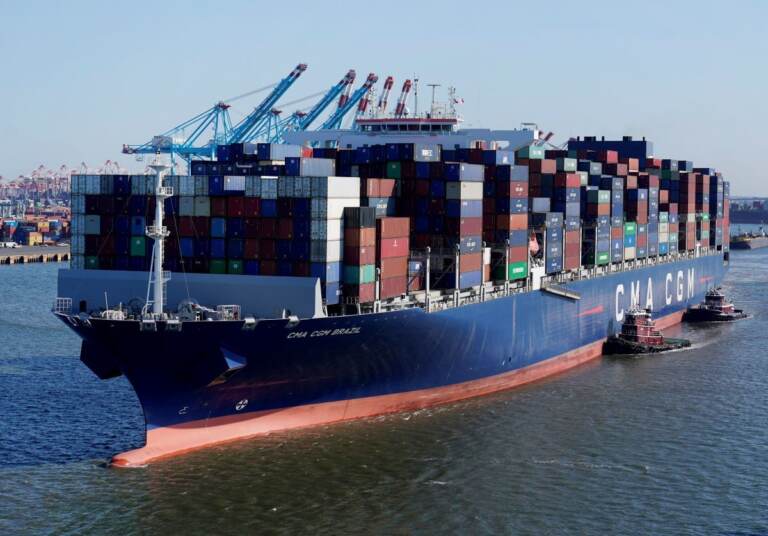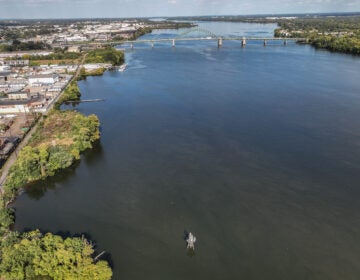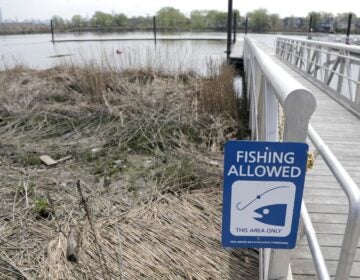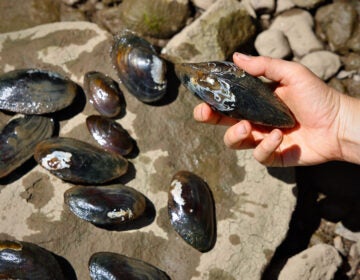Fewer than 250 adult Atlantic sturgeon remain in the Delaware River. Shipping could be its biggest threat
More than 350,000 Atlantic sturgeon once migrated to the Delaware River, but now, there are fewer than 250 adults. A caviar rush depleted stocks in the late 1800s.

(AP Photo/Seth Wenig)
The once plentiful Atlantic sturgeon, which spawned a caviar rush in the northern Delaware Bay in the late 1800’s, now number less than 250 adults according to a new study. Researchers say the new population information could offer clues about the overall health of the Delaware River ecosystem.
Atlantic sturgeon can grow to 14 feet long, weigh up to 1000 pounds and live to 75 years. More than 350,000 once swam up the Delaware River to spawn and lay their sticky clumps of eggs on the rocky bottom. But the population never bounced back from its heyday, and today, new research led by the U.S. Geological Survey shows just one-tenth of 1% of the original population continues to spawn in the Delaware.
The study was published this week in the journal Ecological Applications.
“It’s the first quantitative defensible estimate for the contemporary run size of Atlantic sturgeon in the Delaware river,” said Dr. Dewayne Fox, a professor of fisheries at Delaware State University and one of the study’s authors. “We have a historic estimate based on catch data from the 1890s and early 1900s. When we’re talking about a couple hundred returning, that should worry us.”
Fox says the Delaware River used to host the largest number of spawning Atlantic sturgeon on the East Coast. Factors that limit the sturgeon’s recovery include dams, lack of oxygen, by-catch, and, in the case of the Delaware, Fox says it’s likely strikes from large ships.
While the Delaware is the longest undammed river on the East Coast, the Delaware Bay is also one of the busiest ports in the nation.
“We know they are spawning. The question is, are there things we can do to minimize vessel strikes?” Fox said. “The good news is we have the habitat. The bad news is it’s overlayed with vessels, and how do we get sturgeon and vessels to coexist?”
Atlantic sturgeon spend most of their time out at sea, but migrate to freshwater rivers to spawn. A coastal fishing ban halted their harvesting in 1997, and they were listed under the Endangered Species Act in 2012.
Getting a current count of the Delaware River population has proved dangerous and difficult, because of the busy shipping channel. A dredging project to deepen the river that took place between 2015 and 2016 provided researchers with a chance to get an accurate assessment.
The consultants tasked with protecting the juvenile fish from the dredging activity took genetic samples, and researchers used that data to build a family tree of the Delaware River sturgeon.
It’s a unique population with a unique genetic signature – running simulations that confirmed the genetic data led researchers to a stark conclusion: The Atlantic sturgeon had reached historic lows.
“These new estimates will provide important information resource managers can use to improve the conservation of this endangered fish,” said study co-author Dr. Dave Kazyak, a research fish biologist at the USGS Eastern Ecological Science Center.
Kazyak says his previous research looking at the Atlantic sturgeon population in the Hudson River tells a different story: “In coastal habitats, we typically observe approximately three sturgeon from the Hudson River population for each sturgeon in the Delaware River population.”
Delaware State’s Fox says that unlike the Delaware, the spawning area of the Hudson does not coincide with shipping traffic.
Pending complaint under the Endangered Species Act
This month, the Delaware Riverkeeper Network, which had opposed the 2015 dredging project due to concerns about the sturgeon, sent a notice of intent to sue the National Marine Fisheries Service (NOAA Fisheries) for violating the Endangered Species Act over two new planned projects.
The Riverkeeper objects to NOAA’s Biological Opinions, which led the Army Corps of Engineers to approve permits for the New Jersey Wind Port project in Salem County and the Edgemoor Container Port project across the river in Delaware. Both require dredging operations.
The Delaware Riverkeeper’s Maya van Rossum says NOAA relied on “bad” science, using a study that looked at sturgeon populations in Virginia, rather than what she says is more relevant data collected and published by Delaware State University’s Fox.
The Delaware State data should be used to inform projects in order to mitigate damage to the sturgeon, van Rossum says.
“If they used the proper study, it might show one or both of the projects would impact the continuation of the Delaware river [sturgeon] population,” van Rossum said. “The wind port could still happen…there are so many pathways to what is the final outcome here that protects the sturgeon.”
A spokesperson for NOAA Fisheries said the agency does not comment on pending litigation.
Fox says the sturgeon’s struggles could point to unseen impacts to aquatic life, water quality, and the overall ecosystem of the Delaware River.
“We should think about these fish as a harbinger of our environment, so if these fish aren’t around, it means things are askew,” he said.
WHYY is your source for fact-based, in-depth journalism and information. As a nonprofit organization, we rely on financial support from readers like you. Please give today.







